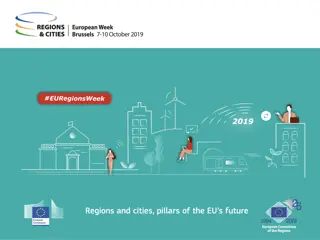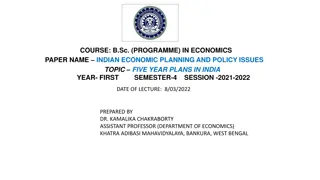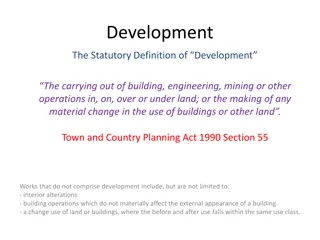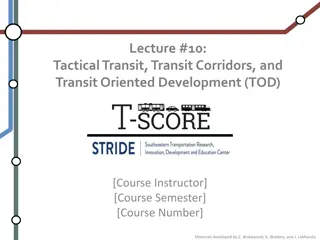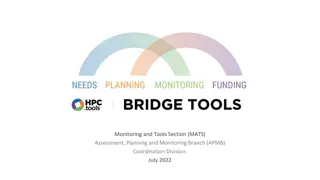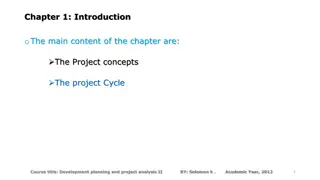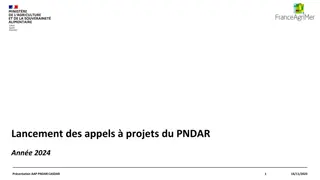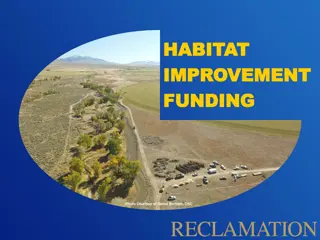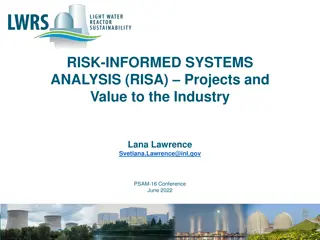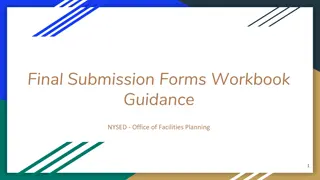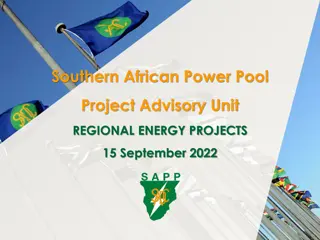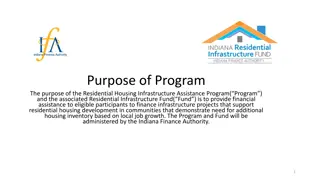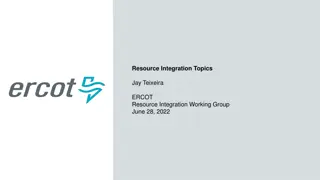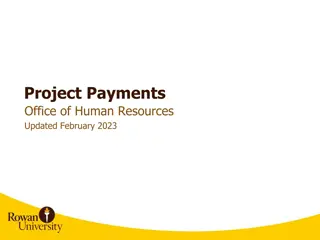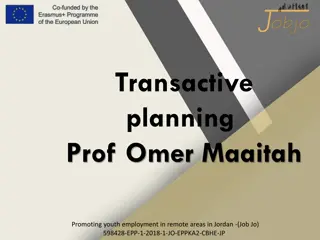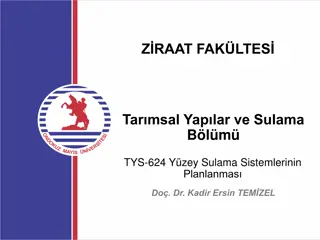Initiating and Planning Systems Development Projects
The lecture covers the key steps involved in initiating and planning systems development projects, such as assessing project feasibility, building project plans, and structured walkthroughs. It delves into the decision-making process between project initiation and planning, the effort required for the PIP process, and the responsibilities involved. Establishing project initiation teams, relationships with customers, initiation plans, management procedures, and project charters are also discussed. The importance of defining clear activities and developing baseline project plans for successful project planning is emphasized.
Download Presentation

Please find below an Image/Link to download the presentation.
The content on the website is provided AS IS for your information and personal use only. It may not be sold, licensed, or shared on other websites without obtaining consent from the author. Download presentation by click this link. If you encounter any issues during the download, it is possible that the publisher has removed the file from their server.
E N D
Presentation Transcript
CSE 414 Systems Analysis and Design Lecture #4 Initiating and Planning Systems Development Projects Prepared & Presented byAsst. Prof. Dr. Samsun M. BA ARICI
Learning Objectives Describe the steps involved in the project initiation and planning process. List and describe various methods for assessing project feasibility. Describe the activities needed to build and review the baseline project plan. Describe the activities and participant roles within a structured walkthrough. Lecture #4 Initiating and Planning Systems Development Projects 2
The Process of Initiating and Planning IS Development Projects FIGURE 5-1 Systems development life cycle with project initiation and planning highlighted Project initiation focuses on activities designed to assist in organizing a team to conduct project planning. Lecture #4 Initiating and Planning Systems Development Projects 3
Initiating and Planning Systems Development Projects What must be considered when making the decision on the division between project initiation and planning (PIP) and analysis? How much effort should be expended on the PIP process? Who is responsible for performing the PIP process? Why is PIP such a challenging activity? Lecture #4 Initiating and Planning Systems Development Projects 4
The Process of Initiating and Planning IS Development Projects (Cont.) Establishing the Project Initiation Team Establishing a Relationship with the Customer Establishing the Project Initiation Plan Establishing Management Procedures Establishing the Project Management Environment and Project Workbook Developing the Project Charter Lecture #4 Initiating and Planning Systems Development Projects 5
The Process of Initiating and Planning IS Development Projects (Cont.) The key activity of project planning is the process of defining clear, discrete activities and the work needed to complete each activity within a single project. The objective of the project planning process is the development of a Baseline Project Plan (BPP) and the Project Scope Statement (PSS). Lecture #4 Initiating and Planning Systems Development Projects 6
The Process of Initiating and Planning IS Development Projects (Cont.) Business Case Justification for an information system Presented in terms of the tangible and intangible economic benefits and costs The technical and organizational feasibility of the proposed system Lecture #4 Initiating and Planning Systems Development Projects 7
Elements of Project Planning Describe project scope, alternatives, feasibility. Divide project into tasks. Estimate resource requirements and create resource plan. Develop preliminary schedule. Develop communication plan. Lecture #4 Initiating and Planning Systems Development Projects 8
Elements of Project Planning (Cont.) Determine standards and procedures. Identify and assess risk. Create preliminary budget. Develop a statement of work. Set baseline project plan. Lecture #4 Initiating and Planning Systems Development Projects 9
Deliverables and Outcomes Baseline Project Plan (BPP) A major outcome and deliverable from the PIP phase Contains the best estimate of a project s scope, benefits, costs, risks, and resource requirements Lecture #4 Initiating and Planning Systems Development Projects 10
Deliverables and Outcomes (Cont.) Project Scope Statement (PSS) A document prepared for the customer Describes what the project will deliver Outlines at a high level all work required to complete the project Lecture #4 Initiating and Planning Systems Development Projects 11
Assessing Project Feasibility Economic Technical Operational Scheduling Legal and contractual Political Lecture #4 Initiating and Planning Systems Development Projects 12
Assessing Project Feasibility (Cont.) FIGURE 5-2 System Service Request for Customer Tracking System (Pine Valley Furniture) Lecture #4 Initiating and Planning Systems Development Projects 13
Assessing Project Feasibility (Cont.) Economic feasibility: a process of identifying the financial benefits and costs associated with a development project Often referred to as a cost-benefit analysis Project is reviewed after each SDLC phase in order to decide whether to continue, redirect, or kill a project Lecture #4 Initiating and Planning Systems Development Projects 14
Determining Project Benefits Tangible benefits refer to items that can be measured in dollars and with certainty. Examples include: reduced personnel expenses lower transaction costs, or higher profit margins. Lecture #4 Initiating and Planning Systems Development Projects 15
Determining Project Benefits (Cont.) Most tangible benefits will fit within the following categories: Cost reduction and avoidance Error reduction Increased flexibility Increased speed of activity Improvement of management planning and control Opening new markets and increasing sales opportunities Lecture #4 Initiating and Planning Systems Development Projects 16
Determining Project Benefits (Cont.) Figure 5-3 Tangible benefits for Customer Tracking System (Pine Valley Furniture) Lecture #4 Initiating and Planning Systems Development Projects 17
Determining Project Benefits (Cont.) Intangible benefits are benefits derived from the creation of an information system that cannot be easily measured in dollars or with certainty. May have direct organizational benefits, such as the improvement of employee morale May have broader societal implications, such as the reduction of waste creation or resource consumption Lecture #4 Initiating and Planning Systems Development Projects 18
Determining Project Benefits (Cont.) Lecture #4 Initiating and Planning Systems Development Projects 19
Determining Project Costs Tangible cost: a cost associated with an information system that can be measured in dollars and with certainty IS development tangible costs include: Hardware costs Labor costs, or Operational costs, including employee training and building renovations. Lecture #4 Initiating and Planning Systems Development Projects 20
Determining Project Costs (Cont.) Intangible cost: a cost associated with an information system that cannot be easily measured in terms of dollars or with certainty Intangible costs can include: Loss of customer goodwill, Employee morale, or Operational inefficiency. Lecture #4 Initiating and Planning Systems Development Projects 21
Determining Project Costs (Cont.) One-time cost: a cost associated with project start-up and development or system start-up These costs encompass activities such as: Systems development, New hardware and software purchases, User training, Site preparation, and Data or system conversion. Lecture #4 Initiating and Planning Systems Development Projects 22
Determining Project Costs (Cont.) Recurring cost: a cost resulting from the ongoing evolution and use of a system Examples of these costs include: Application software maintenance Incremental data storage expenses Incremental communications New software and hardware leases, and Supplies and other expenses (i.e., paper, forms, data center personnel). Lecture #4 Initiating and Planning Systems Development Projects 23
Determining Project Costs (Cont.) Figure 5-4 One-time costs for Customer Tracking System (Pine Valley Furniture) Lecture #4 Initiating and Planning Systems Development Projects 24
Determining Project Costs (Cont.) Figure 5-5 Recurring costs for Customer Tracking System (Pine Valley Furniture) Lecture #4 Initiating and Planning Systems Development Projects 25
Determining Project Costs (Cont.) Both one-time and recurring costs can consist of items that are fixed or variable in nature. Fixed costs are billed or incurred at a regular interval and usually at a fixed rate. Example: facility lease payment Variable costs are items that vary in relation to usage. Example: long-distance charges Lecture #4 Initiating and Planning Systems Development Projects 26
Determining Project Costs (Cont.) Lecture #4 Initiating and Planning Systems Development Projects 27
Determining Project Costs (Cont.) Lecture #4 Initiating and Planning Systems Development Projects 28
The Time Value of Money Time value of money (TVM): the concept that money available today is worth more than the same amount tomorrow Discount rate: the rate of return used to compute the present value of future cash flows (the cost of capital) Present value: the current value of a future cash flow Lecture #4 Initiating and Planning Systems Development Projects 29
The Time Value of Money (Cont.) Net Present Value (NPV) Use discount rate to determine present value of cash outlays and receipts Return on Investment (ROI) Ratio of cash receipts to cash outlays Break-Even Analysis (BEA) Amount of time required for cumulative cash flow to equal initial and ongoing investment Lecture #4 Initiating and Planning Systems Development Projects 30
The Time Value of Money (Cont.) Net Present Value PVn = present value of Y dollars n years from now based on a discount rate of i. NPV = sum of PVs across years. Calculates time value of money Lecture #4 Initiating and Planning Systems Development Projects 31
The Time Value of Money (Cont.) Break-even analysis: a type of cost-benefit analysis to identify at what point (if ever) benefits equal costs Lecture #4 Initiating and Planning Systems Development Projects 32
The Time Value of Money (Cont.) Figure 5-6 Summary spreadsheet reflecting the present value calculations of all benefits and costs for the Customer Tracking System (Pine Valley Furniture) (Source: Microsoft Corporation.) Lecture #4 Initiating and Planning Systems Development Projects 33
The Time Value of Money (Cont.) Figure 5-7 Break-even analysis for Customer Tracking System (Pine Valley Furniture) Lecture #4 Initiating and Planning Systems Development Projects 34
Assessing Technical Feasibility Technical feasibility: a process of assessing the development organization s ability to construct a proposed system Assessment of the possible target hardware, software, and operating environments Consider system size, complexity, and the group s experience with similar systems Lecture #4 Initiating and Planning Systems Development Projects 35
Assessing Technical Feasibility (Cont.) The potential consequences of not assessing and managing risks can include: Failure to attain expected benefits from the project Inaccurate project cost estimates. Inaccurate project duration estimates. Failure to achieve adequate system performance levels. Failure to adequately integrate the new system with existing hardware, software, or organizational procedures. Lecture #4 Initiating and Planning Systems Development Projects 36
Project Risk Factors Project size Team size, organizational departments, project duration, programming effort Project structure New vs. renovated system, resulting organizational changes, management commitment, user perceptions Development group Familiarity with platform, software, development method, application area, development of similar systems User group Familiarity with IS development process, application area, use of similar systems Lecture #4 Initiating and Planning Systems Development Projects 37
Assessing Technical Feasibility (Cont.) Four general rules of risk assessment: 1. Larger projects are riskier than smaller projects. 2. A system in which the requirements are easily obtained and highly structured will be less risky than one in which requirements are messy, ill structured, ill defined, or subject to the judgment of an individual. Lecture #4 Initiating and Planning Systems Development Projects 38
Assessing Technical Feasibility (Cont.) The development of a system employing commonly used or standard technology will be less risky than one employing novel or nonstandard technology. A project is less risky when the user group is familiar with the systems development process and application area than if unfamiliar. 3. 4. Lecture #4 Initiating and Planning Systems Development Projects 39
Assessing Technical Feasibility (Cont.) FIGURE 5-8 Effects of degree of project structure, project size, and familiarity with application area on project implementation risk (Source: Based on 7th Applegate, Austin, and McFarlan. 2007; Tech Republic, 2005.) Lecture #4 Initiating and Planning Systems Development Projects 40
Assessing Other Feasibility Concerns Operational Does the proposed system solve problems or take advantage of opportunities? Scheduling Can the project time frame and completion dates meet organizational deadlines? Legal and Contractual What are the legal and contractual ramifications of the proposed system development project? Political How do key stakeholders view the proposed system? Lecture #4 Initiating and Planning Systems Development Projects 41
Building the Baseline Project Plan A Baseline Project Plan (BPP) is a document intended primarily to guide the development team. Sections: Introduction System description Feasibility assessment Management issues Lecture #4 Initiating and Planning Systems Development Projects 42
Building the Baseline Project Plan (Cont.) Project Scope statement is part of the BPP introduction. Sections: Problem statement Project objectives Project description Business benefits Deliverables Expected duration Lecture #4 Initiating and Planning Systems Development Projects 43
Factors in Determining Scope Organizational units affected by new system Current systems that will interact with or change because of new system People who are affected by new system Range of potential system capabilities Lecture #4 Initiating and Planning Systems Development Projects 44
Diagram Depiction of Project Scope FIGURE 5-11 Context-level data flow diagram showing project scope for Purchasing Fulfillment System (Pine Valley Furniture) Lecture #4 Initiating and Planning Systems Development Projects 45
Building the Baseline Project Plan (Cont.) System description section outlines possible alternative solutions. Feasibility assessment section outlines issues related to project costs and benefits, technical difficulties, and other such concerns. Management issues section outlines a number of managerial concerns related to the project. Lecture #4 Initiating and Planning Systems Development Projects 46
Reviewing the Baseline Project Plan Structured Walkthroughs: a peer-group review of any product created during the system development process Roles: coordinator, presenter, user, secretary, standard-bearer, maintenance oracle Can be applied to BPP, system specifications, logical and physical designs, program code, test procedures, manuals and documentation Lecture #4 Initiating and Planning Systems Development Projects 47
Making an Effective Presentation Presentation planning Audience, message, presentation environment Presentation design Organized, simple, consistent, variety, proof-read, limit bells-and-whistles, appropriate supplemental materials, clear beginning and end Lecture #4 Initiating and Planning Systems Development Projects 48
Making an Effective Presentation (Cont.) Presentation delivery Practice, arrive early, use special software keys for shortcuts, have a backup plan, deliver information effectively, good personal appearance Lecture #4 Initiating and Planning Systems Development Projects 49
E-Commerce Initialization and Planning (PVF) Web-based system costs: Platform web hosting service, web server, server software, plug-ins, firewall, router, internet connection Content and service creative design/devt., ongoing design fees, project mgt., site mgt., content staff, graphics staff, support staff, enhancement funds, licensing fees, programming, consulting, research, training, travel Marketing direct mail, public relations, print advertising, paid website links, promotions, marketing staff, advertising sales staff Lecture #4 Initiating and Planning Systems Development Projects 50







